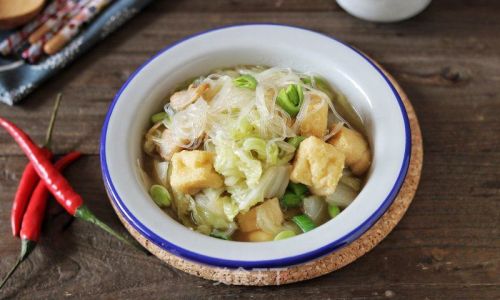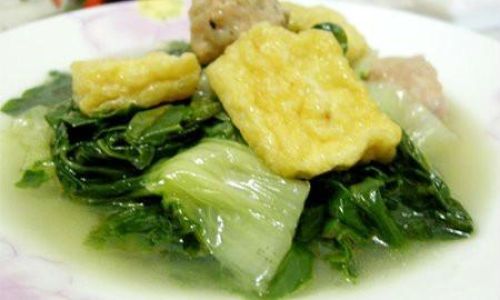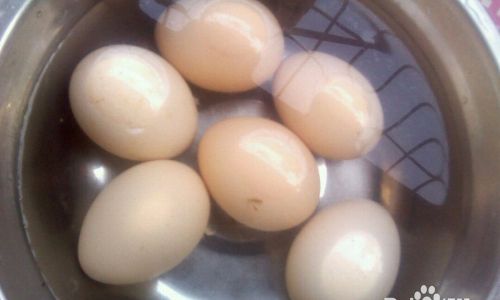Introduction

In the realm of comfort food, stewed dishes hold a special place. They offer a warm, nourishing embrace that satisfies both the palate and the soul. Among the myriad of stewed delicacies, Hearty Stewed Vegetables with Oil Tofu stands out for its simplicity, balance of flavors, and nutritional richness. This dish combines the earthy sweetness of various vegetables with the soft, absorbent texture of oil tofu, all bathed in a flavorful broth that simmers to perfection. Whether you’re looking for a hearty meal to fend off the chill or a nutritious dinner to fuel your day, this recipe promises to deliver.
Understanding the Ingredients
Before diving into the preparation, let’s familiarize ourselves with the key ingredients:
-
Vegetables: The beauty of stewed vegetables lies in their versatility. You can use a mix of seasonal vegetables such as carrots, potatoes, bell peppers, spinach, and broccoli. Each vegetable contributes its unique flavor and texture, creating a harmonious blend.
-
Oil Tofu: Also known as deep-fried tofu or firm tofu that has been pan-seared, oil tofu has a porous structure that readily absorbs the flavors of the broth. Its mild taste makes it an excellent canvas for the spices and herbs in the stew.
-
Broth: The base of any good stew is its broth. You can use vegetable stock, chicken broth, or even a combination of both. Seasoning the broth with soy sauce, garlic, ginger, and black pepper adds depth and complexity to the dish.
-
Aromatics and Seasonings: Garlic, ginger, and onions form the aromatic backbone of the stew. Soy sauce, sesame oil, and a touch of sugar or honey help balance the flavors, ensuring the dish is neither too salty nor too bland.
Step-by-Step Preparation
Now, let’s walk through the process of making Hearty Stewed Vegetables with Oil Tofu.
Step 1: Preparation of Ingredients
Begin by washing and chopping your vegetables into bite-sized pieces. This ensures they cook evenly and are easy to eat. For potatoes and carrots, peeling them first is optional but recommended for a smoother texture. Oil tofu should be cut into cubes or slices, depending on your preference.
Step 2: Preparing the Aromatics
Finely chop garlic, ginger, and onions. These will be the first ingredients to go into the pot, creating a fragrant base for the stew.
Step 3: Sautéing the Aromatics
In a large pot or Dutch oven, heat a tablespoon of vegetable oil over medium heat. Add the chopped garlic, ginger, and onions. Sauté until they become fragrant and the onions start to turn translucent. This process should take about 3-4 minutes.
Step 4: Adding the Vegetables
Once the aromatics are fragrant, add the harder vegetables first – potatoes, carrots, and bell peppers. These take longer to cook and should be given a head start. Stir the vegetables well to coat them with the aromatic oils.
Step 5: Pouring in the Broth
Measure out your broth and pour it into the pot. Ensure the vegetables are fully submerged. If you prefer a thicker stew, you can reduce the amount of broth slightly. Season the broth with soy sauce, a pinch of black pepper, and a teaspoon of sugar or honey to balance the flavors.

Step 6: Simmering the Vegetables
Bring the broth to a gentle boil, then reduce the heat to low. Allow the vegetables to simmer for about 15-20 minutes, or until they are tender but not overcooked. Stir occasionally to prevent sticking and to ensure even cooking.
Step 7: Preparing the Oil Tofu
While the vegetables are simmering, prepare the oil tofu. If you haven’t already, cut it into desired shapes and lightly pan-sear it in a non-stick skillet with a bit of oil. This step is crucial as it not only adds a nice golden crust to the tofu but also helps it absorb more flavors from the broth.
Step 8: Adding the Oil Tofu and Softer Vegetables
Once the harder vegetables are tender, add the oil tofu and any softer vegetables like spinach or broccoli. Continue to simmer for another 5-10 minutes, until the softer vegetables are cooked but still vibrant in color.
Step 9: Final Seasoning and Taste Adjustment
Taste the stew and adjust the seasoning as needed. You may want to add more soy sauce for saltiness, a drizzle of sesame oil for richness, or a pinch of red pepper flakes for a hint of heat. Remember, the flavors should be balanced and not overly dominant.
Step 10: Garnishing and Serving
Once the stew is perfectly cooked, remove it from heat. Garnish with chopped green onions, sesame seeds, or a sprinkle of fresh herbs like cilantro or parsley. Serve hot, accompanied by a side of rice or noodles for a complete meal.
Tips for Perfect Stewed Vegetables with Oil Tofu
-
Seasoning: Always taste and adjust seasoning throughout the cooking process. It’s easier to correct flavors early than to try and fix them after the stew is done.
-
Texture: Pay attention to the cooking times of different vegetables. Harder vegetables need more time to soften, while softer ones can overcook quickly.
-
Aromatics: Don’t skip the sautéing of aromatics. They form the foundation of the stew’s flavor.
-
Broth: Use a good-quality broth for the best results. Homemade stock is always preferable, but high-quality store-bought broth works well too.
-
Tofu: Pan-searing the tofu before adding it to the stew not only enhances its texture but also helps it absorb more flavors.
Conclusion
Hearty Stewed Vegetables with Oil Tofu is a dish that embodies the essence of comfort food. Its rich, flavorful broth, tender vegetables, and absorbent tofu make it a satisfying and nutritious meal. Whether you’re cooking for a family dinner, entertaining friends, or simply treating yourself, this recipe promises to deliver warmth, flavor, and nourishment. With its simple ingredients and straightforward preparation, it’s a dish that anyone can master, turning humble vegetables and tofu into a culinary masterpiece. So, gather your ingredients, follow the steps, and enjoy the hearty, comforting delight of a well-made stew.





0 comments